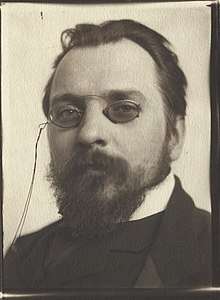Wilfrid Voynich
| Wilfrid Voynich | |
|---|---|
 Voynich in 1900 | |
| Native name | Wilfrid Michał Habdank-Wojnicz |
| Born |
12 November 1865 Telsze, Samogitia, Russian Empire (now Lithuania) |
| Died |
19 March 1930 (aged 64) New York City |
| Nationality | Polish |
| Occupation | Revolutionary, Antiquarian Book Dealer |
| Known for | Discovery of the Voynich manuscript |
| Spouse(s) |
|
Wilfrid Voynich, born Michał Habdank-Wojnicz (Telsze, Samogitia, Lithuania, 12 November [O.S. 31 October] 1865[1] – New York, 19 March 1930), was a Polish revolutionary, antiquarian and bibliophile. Voynich operated one of the largest rare book businesses in the world,[2] but he is best remembered as the eponym of the Voynich manuscript.
Life
Michał Habdank-Wojnicz was born in Telsze, then part of the Russian Empire, now Lithuania, into a Polish-Lithuanian noble family.[3] The "Habdank" part of his surname is the name of a Polish heraldic clan. He was the son of a Polish petty official (titular counsellor).[1]
He attended a gimnazjum in Suwałki (a town in northeastern Poland), then studied at the universities of Warsaw, St. Petersburg, and Moscow. He graduated from Moscow University in chemistry and became a licensed pharmacist.[3]

In 1885, in Warsaw, Wojnicz joined Ludwik Waryński's revolutionary organization, Proletariat. In 1886, after a failed attempt to free fellow-conspirators pl:Piotr Bardowski (1846-1886) and Stanisław Kunicki (1861-1886), who had both been sentenced to death, from the Warsaw Citadel, he was arrested by the Russian police. In 1887, he was sent to penal servitude at Tunka near Irkutsk.
Whilst in Siberia, Voynich acquired a working knowledge of eighteen different languages, albeit not well.[4][5]
In June 1890 he escaped from Siberia and travelling west by train got to Hamburg, eventually arriving in London in October 1890.[6] Under the assumed name of Ivan Kel'chevskii at first, he worked with Stepniak, a fellow revolutionary, under the banner of the anti-tsarist Society of Friends of Russian Freedom in London.[7] After Stepniak's death in a railway crossing accident in 1895, Voynich ceased revolutionary activity.
Voynich became an antiquarian bookseller from around 1897, acting on the advice of Richard Garnett, a curator at the British Museum.[8] Voynich opened a bookshop at Soho Square in London in 1898. He was remarkably lucky in finding rare books, including a Malermi Bible in Italy in 1902.[5]
In 1902 he married a fellow former revolutionary, Ethel Lilian Boole, daughter of the British mathematician George Boole, who Voynich had been associated with since 1890. Voynich was naturalised a British subject on 25 April 1904, taking the legal name Wilfrid Michael Voynich.
Voynich opened another bookshop in 1914 in New York. With the onset of the First World War, Voynich was increasingly based in New York.[9] He became deeply involved in the antiquarian book trade, and wrote a number of catalogues and other texts on the subject.
Voynich relocated his London bookshop to 175 Piccadilly in 1917.[10] Also in 1917, based on rumors, Voynich was investigated by the FBI, in relation to his possession of Bacon's cipher. The report also noted that he dealt with manuscripts from the 13th, 12th, and 11th centuries, and that the value of his books at the time was half a million dollars. However, the investigation did not reveal anything significant beyond the fact that he possessed a secret code nearly a thousand years old.[2]
Voynich died at Roosevelt Hospital in New York, in 1930 of lung cancer.[11]
Voynich manuscript
The most famous of Voynich's possessions was a mysterious manuscript he said he acquired in 1912 at the Villa Mondragone in Italy, but first presented in public in 1915. The book has been carbon dated, and that revealed that it was written somewhere between 1404 and 1438.[12] He owned the manuscript until his death.
See also
References
- 1 2 Деятели революционного движения в России: Био-библиографический словарь: От предшественников декабристов до падения царизма: [В 5 т.]. - М.: Изд-во Всесоюзного общества политических каторжан и ссыльно-поселенцев, 1927-1934. Entry on Voynich
- 1 2 Colin MacKinnon (2013). "The U.S. Bureau of Information File On Wilfrid Voynich" (PDF).
- 1 2 René Zandbergen (2017). "H. Wilfrid Michael Voynich".
- ↑ Symonds, John (1997). "Illustrations from the Wellcome Institute Library Wellcome and Osler". Medical History (41): 213–225.
- 1 2 "Mr. W. M. Voynich." Times [London, England] 22 Mar. 1930: 17. The Times Digital Archive. Web. 10 Apr. 2017.
- ↑ Gerry Kennedy (2016-04-28). The Booles and the Hintons: Two Dynasties That Helped Shape the Modern World. Cork University Press. ISBN 978-1-78205-185-5.
- ↑ Bernhardt, Lewis (Autumn 1966). "The Gadfly in Russia" (PDF). The Princeton University Library Chronicle. 28 (1): 2.
- ↑ The Library World Vol 34 Issue 9
- ↑ Duffy, Eamon (20 April 2017). "Secret Knowledge—or a Hoax?". Retrieved 23 October 2017 – via www.nybooks.com.
- ↑ "The bookseller : a newspaper of British and foreign literature". London : [s.n.] 23 October 2017. Retrieved 23 October 2017 – via Internet Archive.
- ↑ Colin MacKinnon (2013). "Wilfrid Michael Voynich's Certificate of Death And Grave Site" (PDF).
- ↑ "The manuscript is an illustrated medieval codex written by an unknown author between 1404 and 1438." Goldman, Eleonora (20 April 2017). "Russian scholars unlock the secret of the mysterious Voynich manuscript". Retrieved 25 August 2017.
External links
- Biographical information on E. L. Voynich and W. M. Voynich by Rafał T. Prinke
- History Files article on Voynich
- Genealogy of Wilfrid Voynich: http://www.wikitree.com/wiki/Wojnicz-20